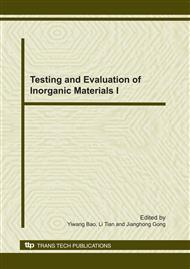p.364
p.369
p.373
p.378
p.382
p.386
p.390
p.394
p.398
Optimization of Sintering Temperature and Doping Level of Cr2O3 in ZnO-Pr6O11-Based Varistor Ceramics
Abstract:
The electrical properties of ZnO-Pr6O11-based varistors, which composed of (98.5-x)mol% ZnO +0.5mol% Pr6O11 +1.0mol% Co3O4 +xmol% Cr2O3 (x=0.0, 0.25, 0.5, 1.0, 2.0), were investigated as a function of sintering temperature in the range of 1250-1400°C for 2 h. At the same sintering temperature, the nonlinear exponents increased with the increase of Cr2O3 doping amount no more than 0.5mol%, but decreased with more Cr2O3 doped. With the same doping level of Cr2O3, the samples' varistor voltage decreased with the sintering temperature increased; and the samples' nonlinear exponents increased first with the sintering temperature increased to 1300 °C, but decreased when the temperature increased further. Conclusively, the electrical properties of ZnO-Pr6O11-Co3O4- Cr2O3 varistors were strongly affected by the sintering temperature and the doping level of Cr2O3, and the samples, doped with 0.5 mol% Cr2O3 and sintered at 1300 °C, exhibited the optimum nonlinear performance.
Info:
Periodical:
Pages:
382-385
Citation:
Online since:
December 2010
Authors:
Price:
Сopyright:
© 2011 Trans Tech Publications Ltd. All Rights Reserved
Share:
Citation:


